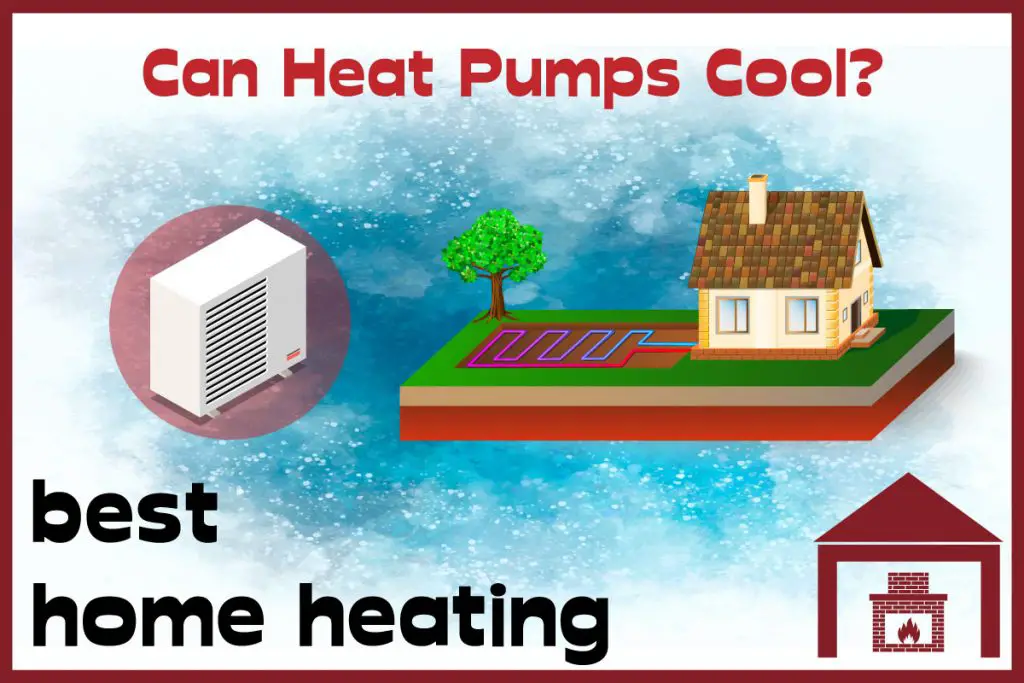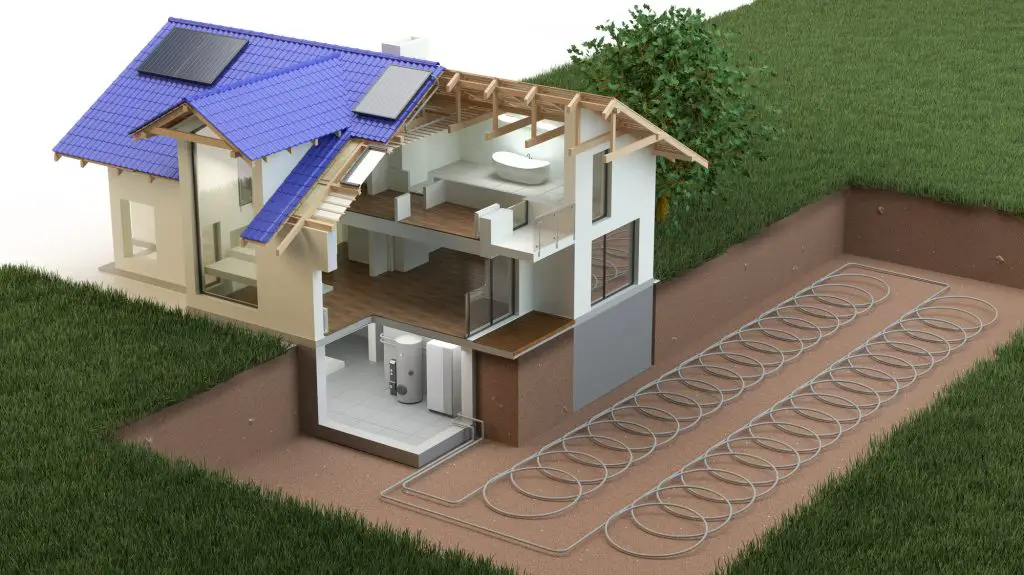In recent years, both ground source and air source heat pumps have gained immense popularity as promising green technologies. Many people who are interested in heat pumps wonder if these systems can also provide cooling.
Heat pumps can provide cooling. They are as efficient for cooling during the summer as air conditioners are. During summer, a ground source or air source heat pump can just reverse the process and act as an AC unit. The refrigerant extracts the hot air from the room and replaces it with cool air absorbed it absorbs.
In this post, we are going to discuss everything you need to know about the cooling properties of ground source and air source heat pumps.

How do Ground Source Heat Pumps work and can they provide cooling?
The ground absorbs low-grade solar energy through direct sunlight and rain. As a result, just a few feet below the surface, the ground has a year-round temperature of 8-12 degrees Celsius. A ground source heat pump absorbs this heat by circulating a fluid through pipework in the ground.
The system then compresses and condenses the fluid—a process that raises the temperature. The heat is then transferred to the home typically via radiators, or an underfloor system. The fluid then returns to the submerged pipework, and the cycle continues. During the summer, the process is just reversed, and therefore the system provides cooling. It works on the principle that heat flows from warmer to cooler places.

Let’s go a little bit deeper. In essence, the heat transfer process works in reverse. The heat pump absorbs heat circulating inside your house and transfers the heat via the fluid to the ground, which is at a lower temperature of around 55°F. The heat dissipates to the ground, and consequently the temperature inside the house drops.
How is the cooling distributed across the room?
To provide cooling, both radiators and underfloor systems can be used with ground source heat pumps–at least theoretically. However, it should be noted here that radiators are not a very good option for this purpose, because cool water does not provide sufficient cooling via the radiator surface. Heat pumps are low-flow temperature systems and therefore work better with an underfloor heating system (in this case, used to provide cooling).
However, when using underfloor heating pipework for cooling purposes, it is important to be careful about floor finishes. Condensation can form on chilled floors, and that can lead to a slip risk. The risk can be significantly reduced by keeping the dew point and relative humidity in check. Dew point sensors can be very useful for this purpose.
When an air or ground source heat pump is used for cooling, installing a chilled beam is the best option. When it comes to providing cooling, neither a radiator nor an underfloor system is as efficient as a chilled beam.
How do Air Source Heat Pumps work and can they provide cooling?
First, let’s see how an air source heat pump works. The unit takes heat from the outside air. The heat is absorbed by a liquid refrigerant. Then the system compresses the liquid refrigerant—a process that raises the temperature of the liquid. The heat stored in the liquid is then sent to an underfloor heating system, radiator, or both.
When cooling is required, an air source heat pump works in reverse and therefore works a bit like a refrigerator. The flow of refrigerant is reversed, and the condenser coils and evaporator switch roles.
The refrigerant, which has a lower temperature than the indoor air, absorbs heat from the indoor air. The refrigerant is then put through the compressor, which heats the liquid and turns it into a gas. The heat is then transferred to the outside air via the condenser coils. The refrigerant then turns liquid again, cools down to below the room temperature, and the cycle is repeated.

When it comes to providing cooling with an air source heat pump, using underfloor heating or radiators is not a very good idea. They work pretty well when they are used for providing heat, but for cooling, there is a better option—chilled beams.
A chilled beam is a type of radiation system used to provide cooling. Pipes of water are passed through a beam, which is essentially a heat exchanger. The beam is attached to the ceiling of a room. Warmer air rises to the chilled beam. As the air comes in contact with the beam, the air cools down, condenses, and then falls downward.
Hot air rises and cool air falls downward, and this principle explains why a chilled beam is a good option for providing cooling with a heat pump.
Ground Source Heat Pump Cooling in More Detail
A great thing about a geothermal heat pump is that it eliminates the need for two distinctly different systems for heating and cooling. You don’t have to install and maintain separate pieces of HVAC equipment, and that saves you space, money, and other headaches.
Ground source heat pumps produce chilled water at typical low temperatures, and that’s part of the reason these heat pumps are ideal for chilled beam systems. Both air source and ground source heat pumps can operate with lower energy than traditional chillers and boilers.
The chilled water flowing through the chilled beam is usually around 14-16˚C. The return temperature of the water is 2-4˚C. If your geothermal system provides low cooling or no cooling, there may be one or multiple issues with the system. They may be caused by the following:
- Clogged Air Filter: This restricts the movement of air from one location to another, hence heat would not be transferred properly. Failure to unclog the system could lead to other severe problems that could damage the system.
- Compressor: If there is an issue with the compressor of your heat pump, the system will not provide sufficient cooling. The compressor also helps to pressurize the anti-freeze which helps to raise its temperature. Fix the issue so that the compressor can pressurize the anti-freeze.
- Leaks: This disrupts the heating/cooling cycles in the system.

Is this just an added benefit of air/ground heat pump heating systems? Or are there extra costs and components?
A geothermal system, whether it is used for heating or cooling, has three main components: the heat pump, the heat exchange medium, and the delivery system (radiator/underfloor system/chilled beam).
So, if you already have a ground or air source heat pump installed in your home, theoretically it should provide both heating and cooling, without requiring any additional components. However, for the best results, you may want to get chilled beams installed and use them instead of your radiators when cooling is required.
In general, a geothermal heat pump has a COP (coefficient of performance) of 3 to 5. That means, that for every unit of energy used to power the system, it can supply 3 to 5 units of energy in the form of heating or cooling.
The efficiency of a heating or cooling system is measured and compared by Energy Efficiency Ratio (EER). This ratio is calculated by dividing the energy output by the energy input. Geothermal cooling is significantly more efficient than conventional air conditioning. While a conventional AC system has an EER of around 10, a geothermal system has an EER of 15 or more.
While central AC systems are noisy, ground source cooling systems are much quieter. Just like a conventional AC unit, a geothermal cooling system runs on electricity. But the latter is more sustainable because it uses very little electricity.
Both air and ground source heat pumps are environmentally friendly because they generate significantly fewer greenhouse gases than conventional heating and cooling systems. By using a geothermal cooling system you can save up to 50 percent on the cooling bill.
Check out my dedicated article about ground source heat pumps and the environment.
Conclusion – Main Considerations when cooling a home with an air or ground source heat pump
Both air and ground source heat pumps provide cooling. While a ground source heat pump requires excavation of land, an air source heat pump is a lot easier to install. Ground source heat pumps are more effective and more environmentally friendly, but they are also more expensive.
Whether you use an air source heat pump or ground source heat pump for cooling, you can use your existing radiators or underfloor system. And if you want to get the best out of the technology, consider installing chilled beams.
